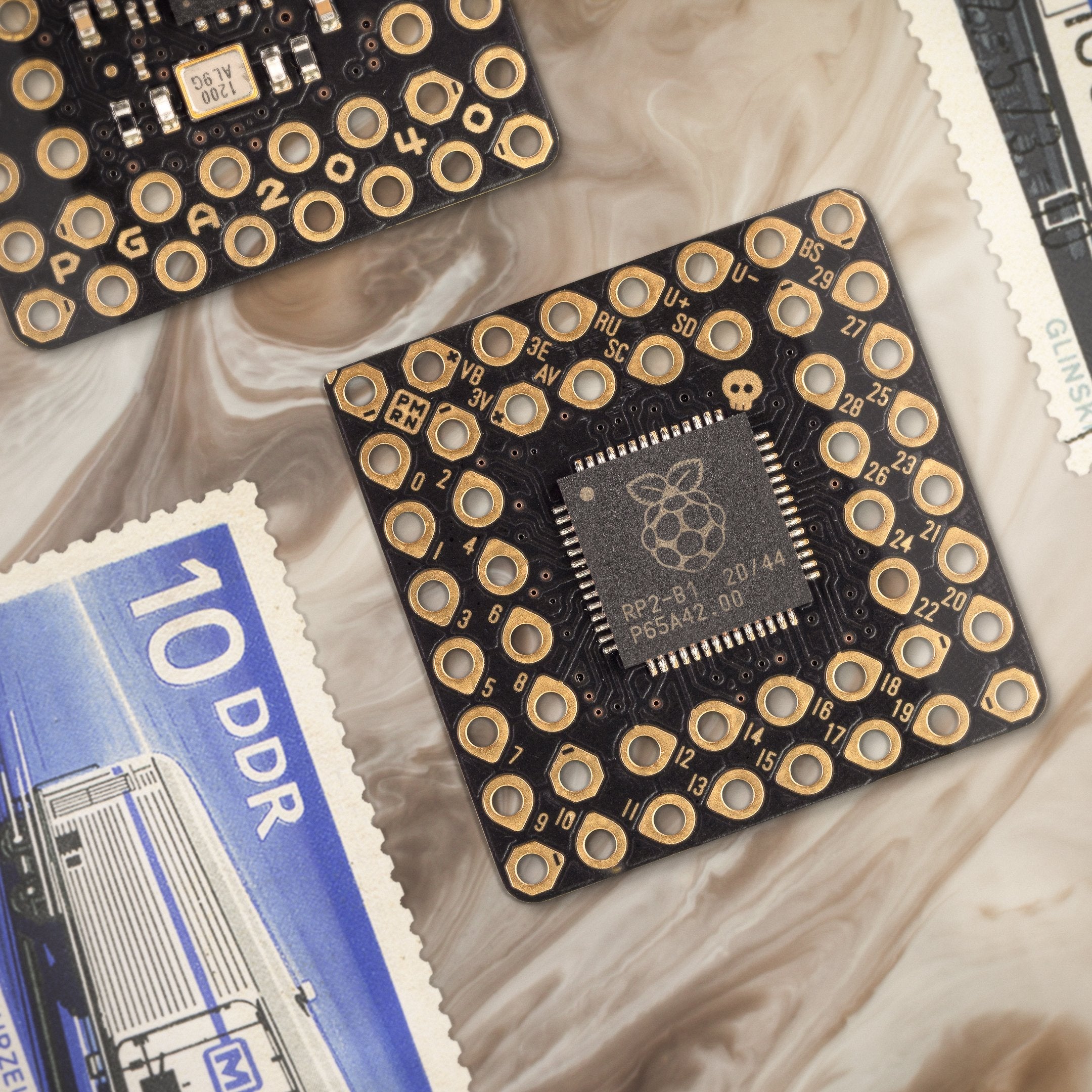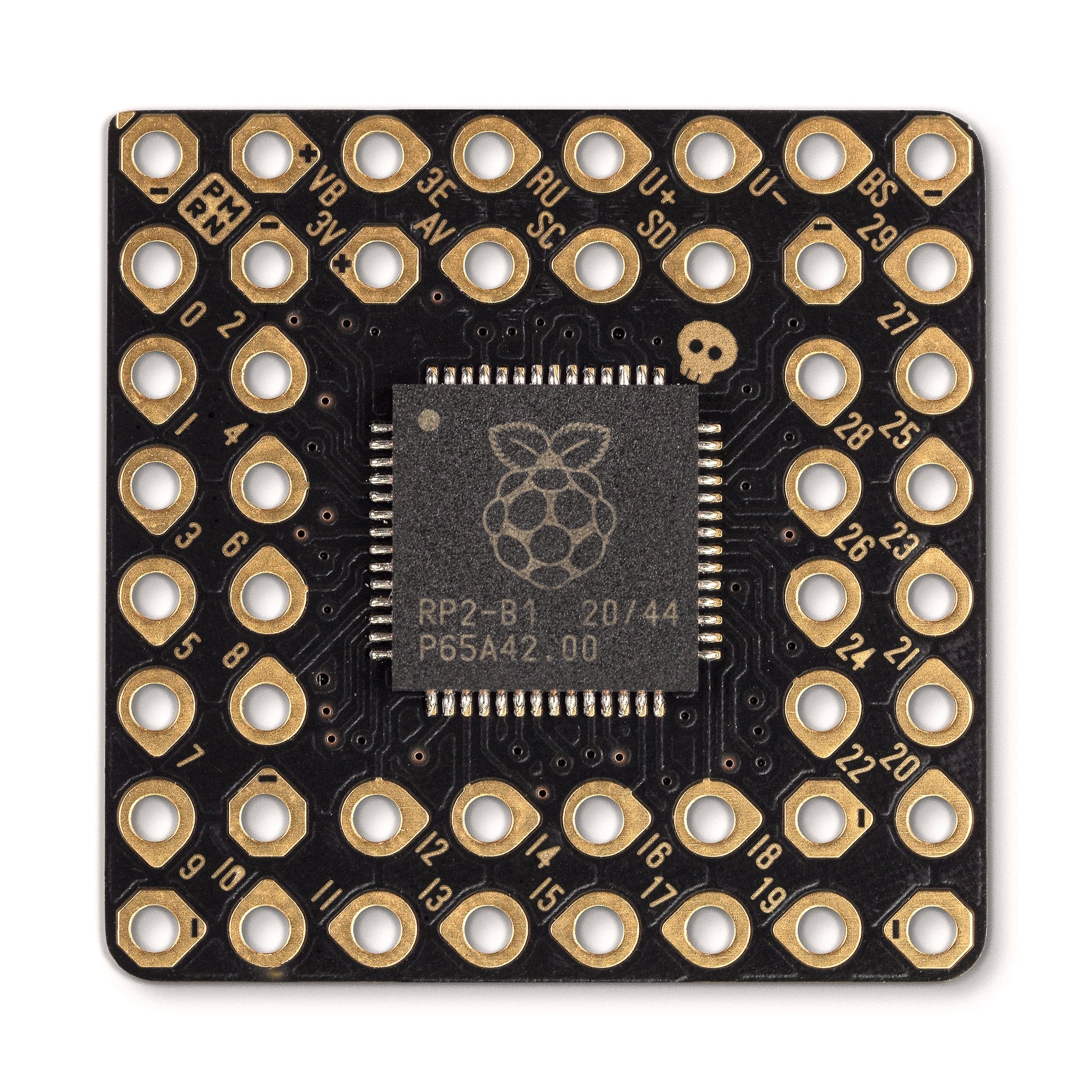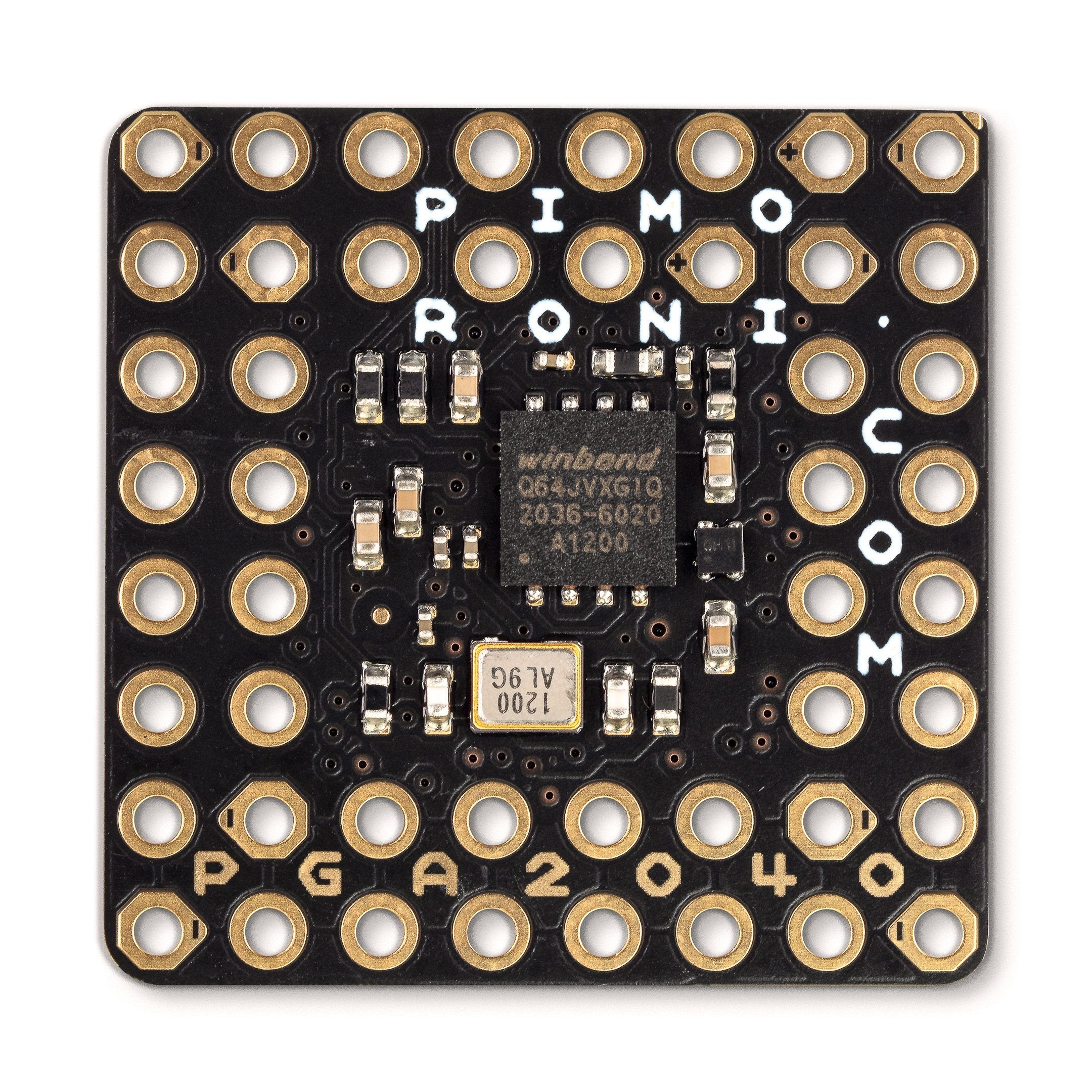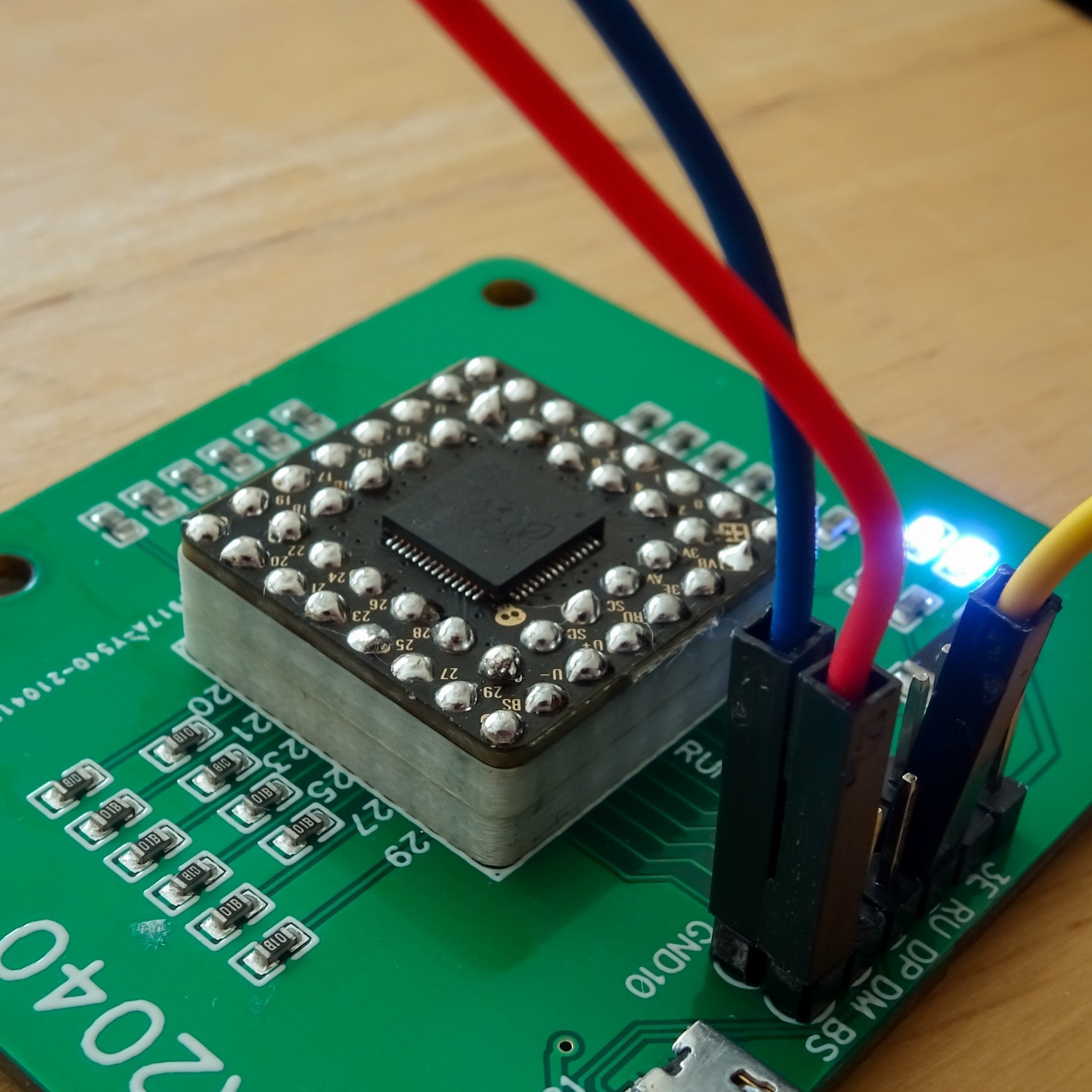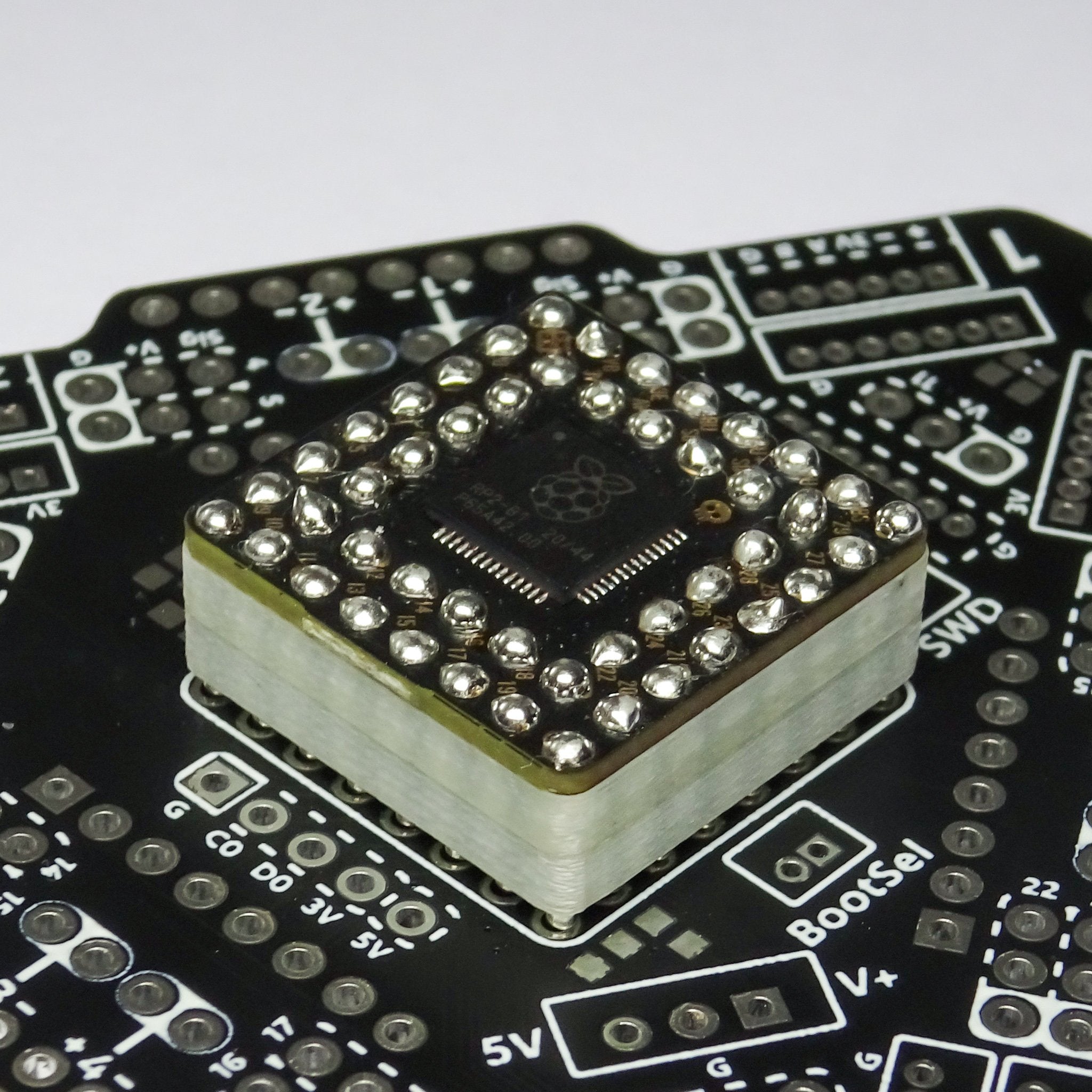Ein minimales RP2040-Breakout-Board, das zu einem Pin Grid Array zusammengefügt wurde, mit 8MB Flash und im Retraux-Stil.
PGA2040 ist ein kompaktes RP2040-Breakout und ist für die schlankesten und einbettungsfähigsten Projekte gedacht. Es enthält nur die Komponenten, die für den Betrieb des RP2040 erforderlich sind (d.h. Quarz, Blitzlicht, Regler und wichtige Unterstützungsschaltungen), und es hat keinen Schnickschnack wie LEDs, Tasten und USB-Anschlüsse - Sie müssen Ihren eigenen USB-Anschluss anschließen, um es programmieren zu können.
Die Vorteile dieser drastischen Beschneidung sind eine winzige, 21mm quadratische Grundfläche und viele freiliegende RP2040-Pins zum Spielen! 30 von ihnen können als Allzweck-I/O verwendet werden (das sind vier mehr I/O als bei einem Raspberry Pi Pico) und 4 sind mit einem ADC ausgestattet. Es hat auch die niedlichsten kleinen Pin-Etiketten im bekannten Universum, weil Platz der eng ist.
Header Pins sind separat erhältlich - Sie können Standard-Pico-Stiftleisten anlöten (aber bedenken Sie, dass Sie 48 Pins benötigen, wenn Sie es vollständig bestücken wollen). Wenn Sie sich ganz der Ästhetik verschreiben wollen, wird Pimoroni auch eine kundenspezifische PGA-Stiftleiste und Buchse herausbringen, um den PGA2040 in ein komplettes Faux-Retro-486-Ära-Gerät zu verwandeln, das in Ihre Projekte eingesteckt (und wieder ausgesteckt) werden kann.
Wie Pimoronis andere RP2040-Boards ist auch das PGA2040 mit C++, MicroPython oder CircuitPython programmierbar - Choose your Fighter!
Eigenschaften
- Angetrieben von RP2040
- Zwei ARM Cortex M0+ mit bis zu 133Mhz
- 264kB SRAM
- 8 MB QSPI-Flash mit Unterstützung für XiP
- Kristalloszillator
- Integrierter 3V3-Regler (max. Ausgangsstrom des Reglers 300mA)
- 48 Stifte, angeordnet mit 2,54mm (0,1") Abstand in einem Pin Grid Array
- 30 Multifunktions-Allzweck-IO (4 können für ADC verwendet werden)
- 8 GND-Stifte
- Eingangsspannungsbereich 3V - 5,5V (nur am VB-Pin)
- Abmessungen: ca. 21mm x 21mm x 3mm (L x B x H)
- Schematische Darstellung
- Eagle CAD-Teil
Erste Schritte
Der PGA2040 ist firmwareunabhängig! Sie können ihn mit C/C++ oder MicroPython auf die gleiche Weise programmieren wie einen Raspberry Pi Pico. Sie finden (viele) weitere Informationen dazu (sowie Download-Links für die Firmware/SDK) auf der RP2040 Landing Page.
Sie können auch CircuitPython auf Ihrem PGA2040 verwenden! CircuitPython ist ein einfach zu bedienendes, gut etabliertes Ökosystem mit vielen Beispielen und Treibern für die Verbindung mit verschiedenen Arten von Hardware. Klicken Sie hier zum Herunterladen der CircuitPython-Firmware für PGA2040 und hier klicken für eine Anleitung zum Einstieg.
Um den PGA2040 über USB zu programmieren müssen Sie Drähte an VB, GND, U+ und U- anschließen. Stellen Sie sicher, dass die 5v nur an VB auf dem PGA2040 angeschlossen werden, sonst kann es zu Schäden kommen. Eine USB-Breakout-Platine ist eine bequeme Möglichkeit, an die Drähte in Ihrem USB-Kabel zu gelangen.
Um in den BOOTSEL-Modus wechseln damit Sie Firmware auf Ihren PGA2040 flashen können, verbinden Sie den BS-Pin mit Masse, während Sie den USB-Stecker in Ihren Computer stecken.
Über RP2040
Der RP2040-Mikrocontroller des Raspberry Pi ist ein Dual-Core ARM Cortex M0+, der mit bis zu 133 MHz läuft. Er verfügt über 264kB SRAM, 30 Multifunktions-GPIO-Pins (einschließlich eines vierkanaligen 12-Bit-ADC), einen Haufen Standardperipheriegeräte (I2C, SPI, UART, PWM, Taktgeber usw.) und USB-Unterstützung.
Ein sehr interessantes Merkmal des RP2040 sind die programmierbaren IOs, die es Ihnen ermöglichen, benutzerdefinierte Programme auszuführen, die GPIO-Pins manipulieren und Daten zwischen Peripheriegeräten übertragen können - sie können Aufgaben auslagern, die hohe Datenübertragungsraten oder ein präzises Timing erfordern, was traditionell eine Menge Arbeit für die CPU bedeutet hätte.
English Description
A minimal RP2040 breakout board wrangled into a Pin Grid Array, with 8MB flash and a maximal dash of retraux style.
PGA2040 is a compact RP2040 breakout intended for the most svelte and embeddable of projects. It contains only the components necessary to run the RP2040 (that's the crystal, flash, regulator and essential support circuits) and it has no fripperies like LEDs, buttons and USB connectors - you'll need to attach your own USB connector to be able to program it.
The benefits of all this drastic pruning are a tiny, 21mm square footprint and lots of exposed RP2040 pins to play with! 30 of them can be used as general purpose I/O (that's four more I/O than on a Raspberry Pi Pico) and 4 are ADC-equipped. It also has the cutest little pin labels in the known 'verse, because space is tight on this board.
Header pins are sold separately - you can solder it to standard Pico pin headers (though bear in mind you'll need 48 pins if you want to populate it fully). If you want to fully commit to the aesthetic Pimoroni will also be releasing a custom PGA pin header and socket to turn PGA2040 into a full faux-retro 486-era device that can be plugged into (and unplugged from) your projects.
Like Pimoroni's other RP2040 boards, PGA2040 is programmable with C++, MicroPython or CircuitPython - choose your fighter!
Features
- Powered by RP2040
- Dual ARM Cortex M0+ running at up to 133Mhz
- 264kB of SRAM
- 8MB of QSPI flash supporting XiP
- Crystal oscillator
- On-board 3V3 regulator (max regulator current output 300mA)
- 48 pins, arranged with 2.54mm (0.1") spacing in a Pin Grid Array
- 30 multi-function General Purpose IO (4 can be used for ADC)
- 8 GND pins
- Input voltage range 3V - 5.5V (on VB pin only)
- Measurements: approx 21mm x 21mm x 3mm (L x W x H)
- Schematic
- Eagle CAD part
Getting Started
PGA2040 is firmware agnostic! You can program it with C/C++ or MicroPython in the same way as you would a Raspberry Pi Pico. You can find (lots) more information on how to do that (as well as download links for the firmware/SDK) on the RP2040 landing page.
You can also use CircuitPython on your PGA2040! CircuitPython is an easy to use, well-established ecosystem with lots of example code and drivers for interfacing with different kinds of hardware. Click here to download the CircuitPython firmware for PGA2040 and click here for a getting started guide.
To program PGA2040 via USB you will need to hook wires up to VB, GND, U+ and U-. Make sure that the 5v only goes to VB on PGA2040, if it ends up elsewhere it will result in a bad time. A USB breakout board is a convenient way of getting at the wires in your USB cable, check out the extras tab for some options!
To get into BOOTSEL mode so you can flash firmware to your PGA2040, connect the BS pin to ground whilst plugging the USB into your computer.
About RP2040
Raspberry Pi's RP2040 microcontroller is a dual core ARM Cortex M0+ running at up to 133Mhz. It bundles in 264kB of SRAM, 30 multifunction GPIO pins (including a four channel 12-bit ADC), a heap of standard peripherals (I2C, SPI, UART, PWM, clocks, etc), and USB support.
One very exciting feature of RP2040 is the programmable IOs which allow you to execute custom programs that can manipulate GPIO pins and transfer data between peripherals - they can offload tasks that require high data transfer rates or precise timing that traditionally would have required a lot of heavy lifting from the CPU.
Sicherheitsangaben
- Lesen Sie die Bedienungsanleitung sorgfältig durch, bevor Sie das Produkt verwenden.
- Stellen Sie sicher, dass alle Montage- und Installationsanweisungen des Herstellers sorgfältig befolgt werden.
- Verwenden Sie das Produkt nur für den vorgesehenen Zweck.
- Die unsachgemäße Nutzung dieses Produkts kann zu schweren Verletzungen oder Sachschäden führen.
- Nicht für Kinder unter 10 Jahren geeignet.
- Bei unsachgemäßer Verwendung besteht eine Verletzungsgefahr.
- Dieses Produkt entspricht den geltenden Sicherheitsanforderungen der Europäischen Union.
- Dieses Produkt wurde gemäß der GPSR geprüft, die sicherstellt, dass alle relevanten Sicherheitsanforderungen für Konsumgüter eingehalten werden.
Nachverfolgbarkeitsinformationen
Jedes Produkt verfügt über eines oder mehrere der folgenden Merkmale:
- Ein CE-Kennzeichen, das die Einhaltung der Sicherheits-, Gesundheits- und Umweltschutzanforderungen der Europäischen Union anzeigt.
- Eine eindeutige Serien- oder Chargennummer, um die Nachverfolgbarkeit zu gewährleisten und bei Bedarf Rückrufaktionen zu unterstützen.
- Hersteller- und Importeurangaben für den Kundensupport und Sicherheitsanfragen.
Überwachung und Berichterstattung von Vorfällen
Für den unwahrscheinlichen Fall eines Produktproblems haben wir Verfahren implementiert, um:
- Kundenbeschwerden zeitnah bearbeiten.
- Schwerwiegende Vorfälle über das EU Safety Gate/RAPEX-System melden.
- Mit den Marktüberwachungsbehörden zusammenarbeiten, um die öffentliche Sicherheit zu gewährleisten.
Kontakt:
- Email: support [@] pi3g.com
- Telefon: 0341 / 392 858 40
Dieses Produkt ist vollständig mit allen geltenden EU-Vorschriften konform, um die Sicherheit unserer geschätzten Kunden zu gewährleisten.

